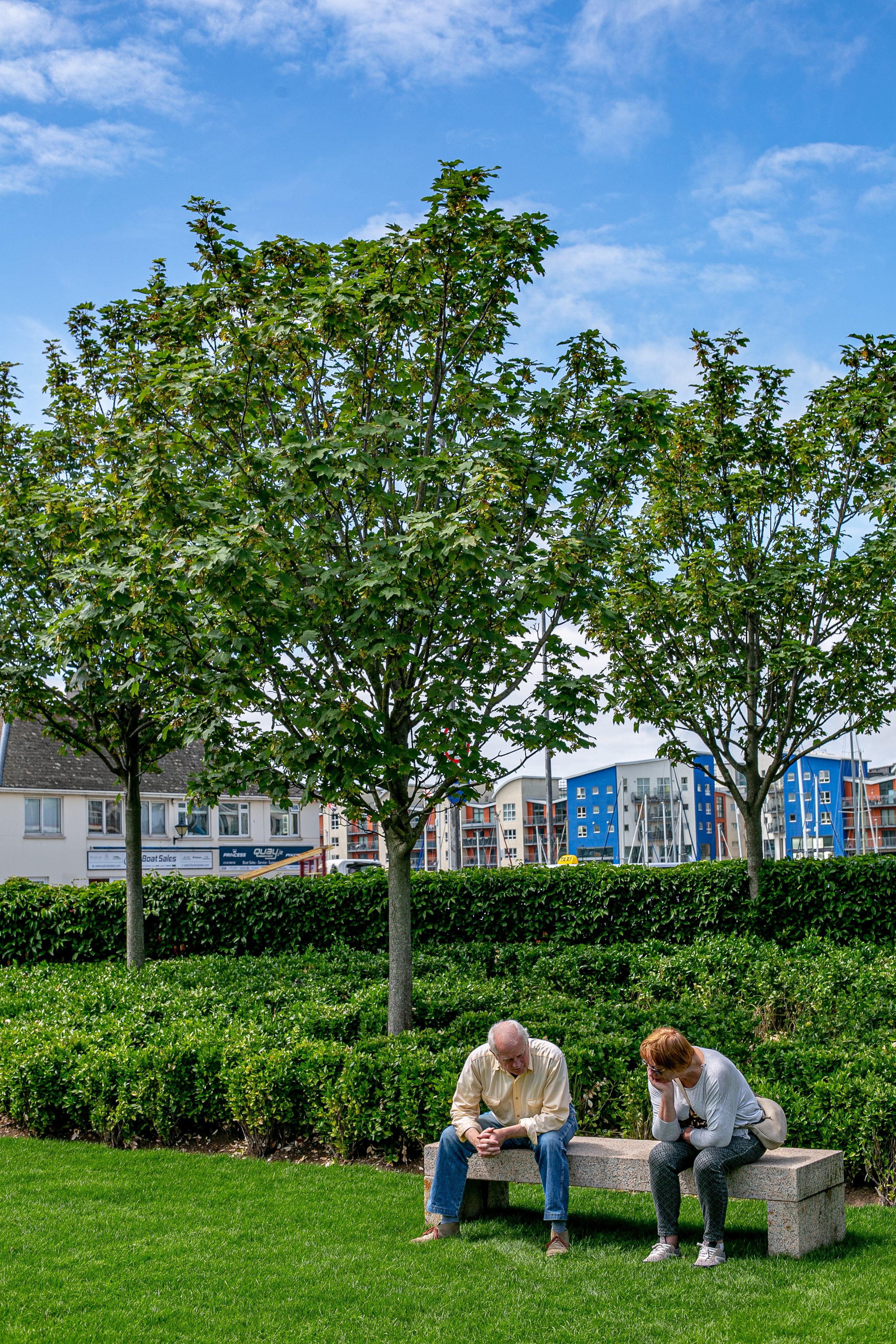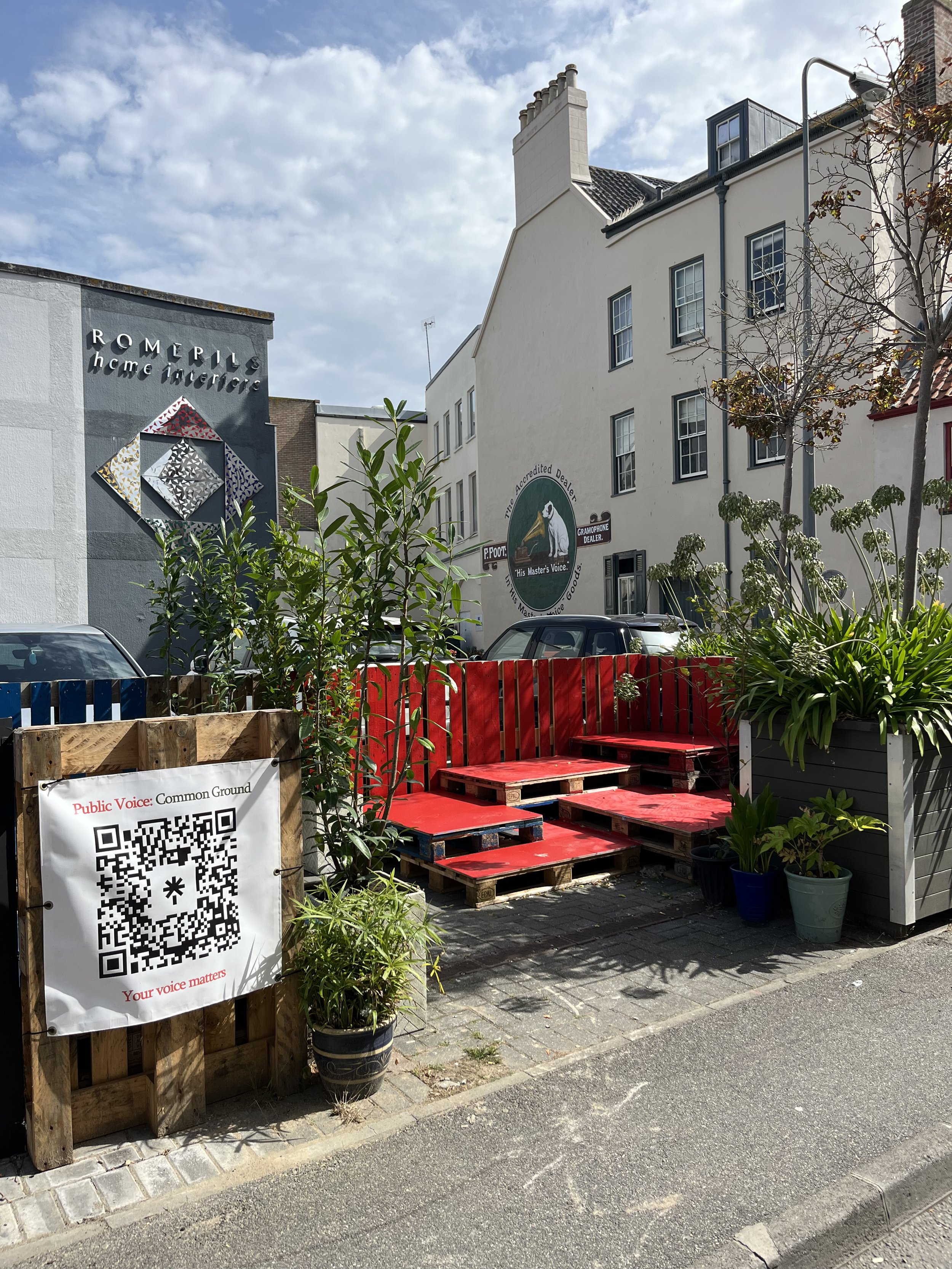Summary
A thriving public realm is somewhere people want to live, work, and spend time. It is good for the economy, community wellbeing and environment.
Public Voice: Common Ground was a pilot commissioned by the States of Jersey to understand how its public realm could be improved. The pilot and its’ insight were presented as an example of innovative and best practice at the British Irish Council’s ‘Placemaking in Practice’ symposium, Cardiff, September 2023. View the article here.
The pilot developed from earlier research to improve Jersey’s Public Realm that was part-sponsored by the government’s Economy Department (Gibb 2022). This analysis illustrated St Helier as the priority, with a consensus for more green space, trees, and places to hang out with no agenda. The Public Voice: Common Ground pop-up sites were based on these priorities.
Purpose
To deliver public realm improvement based on what’s needed.
To lead relevant public engagement that enables this.
To facilitate co-creation and value to all public realm stakeholders.
In 2022 98% pupils at Springfield School had no green space at home.
Public Engagement Methodology
The engagement priority was to engage as many demographics as possible - particularly those not generally engaged with culture, politics, or community. This required a complex series of public engagement events working with many partners.
A mixed method approach combined qualitative and quantitative data and analysed this in the context of specific environmental and community secondary data:
Online Surveys: The survey was anonymous and self-completed in English, Portuguese and Polish.
Interviews and discussions: The online survey was supported by face-to-face interviews and discussions. This revealed a community-led set of themes that added richness to data from the other methods.
Temporary sites – a living lab approach: Co-designed, co-funded, and co-delivered with partners across sectors, the temporary pop-up sites were designed to engage the public and show what is possible. Chalkboards asking visitor feedback were monitored daily. Changes in behaviour, site use and dwell time were also recorded.
Workshops and events: Free community workshops and events engaged a diverse audience using art as a common language. All who took part were on an equal footing, regardless of ability, age, language, or background. The main workshops were:
‘What does Wonderful look like for St Helier?’, Children’s Day. A drawing workshop asking participants to imagine what would improve St Helier for its people.
Earthworks, Pop-up Park. A 2-day clay workshop facilitated by London-based artist Jo Pearl. Local potters and the Jersey community built an imaginary clay scape of a St Helier where everyone wanted to spend time. View the video below.
Lé Galvaûdeux (Jèrriais for ‘the wanderer’). A walk by Jersey artist Tim le Breuilly illustrated by artist/ film maker Marc Medland. The walk inspired all to look at St Helier through new eyes. The artist gave a guided walk and print workshop, and all were encouraged to share what they discovered to Instagram.
In Jersey, community data had not been collected or analysed in this way before. The analysis is in the context of the 2023 Violence Against Women and Girls (VAWG) report, government strategies and global research on public realm and placemaking.
Earthworks, Pop-up Park
Earthworks was a series of free public engagement workshops designed to gather rich data regarding public realm improvement. The workshops were led by London artist Jo Pearl and Public Voice: Common Ground in partnership with Jersey Development Company, Creative Island Partnership and Government of Jersey.
“Good public realm is a human right. It needs to be about people, not just buildings. It needs green spaces… there needs to be a re-education back to walking and away from the car”.
St Helier resident and care worker
Results
Over 2,100 (2%) residents voluntarily shared their insight to Public Voice: Common Ground. Having such unusually large community engagement illustrated the urgency of creating better public realm for people. Anonymised data enabled all views to have equal value. Using a mixed and multiple methodology enabled a level of insight that would not be possible through a survey method alone.
Interviews and discussions engaged nearly 500 locals. These included students, mental health charities, Youth Services, Portuguese, business and disabled communities. This method had the impact of raising the percentage of youth engagement from 16% in the survey to 23% overall.
The pop-up park created a multi-use space with lawn and planting in a previous hard landscape. Total dwell time increased 5-fold in a 30-minute period. 97% said they wanted the grass to stay.
The pop-up perch created seating for 35 out of 4 car parking spaces. 98% of chalk board responses said they’d like to see more public places with seating like this in St Helier.
Over 160 islanders took part in Earthworks. The workshops resulted in a lidar recording of the clay model, interviews, film, and photography. It led to further clay workshops and a proposal for a community pottery studio.
At What does Wonderful Look Like? 62 children took part in the drawing workshop. The insight ranged from more ice cream to outdoor pianos, chess, and dog parks.
Online and in person communities developed from the events. These including an honorary, self-appointed site-guardian at the pop-up park and a film screening championing local film makers at the Perch. Hundreds of artworks were inspired by Lé Galvaûdeux, leading to public exhibitions in empty shops in the High St.
Together, all the findings collected by Public Voice: Common Ground provide a unique understanding of what matters to the community. After rigorous analysis, the re-occurring data themes revealed 4 priorities:
1. Green and wild space for the community.
2. Traffic and access.
3. Social infrastructure – urban seating and places to come together.
4. Entertainment, culture, and community.
These are evidenced further within the main report.
Conclusion: from words to action
The pilot engaged and inspired through relevant, specific, and meaningful public engagement. It enabled co-operation between government, business, 3rd sector and community and delivered value through co-creation and shared resource.
It illustrated what is possible through temporary intervention, leading to further investment by business and public sector in public realm improvement.
It led to new cross department collaboration between government departments such as Infrastructure, Policy, and Economic Development. It served as a case study for more public seating trials in parking spaces and an intention to review the design of public green space by landowners. It has resulted in reassessment of the Percentage for Art policy and related SPGs and the creation of a Public Art Commission to advise government and business on public realm improvement and commissioning.
Most importantly, the project acted as a guide through the process of relevant, inclusive public engagement - finding the problems and supplying a basis for better decision-making regarding the public realm. It illustrated the value of effective methodologies of public engagement in creating spaces that enable communities to thrive, and cities to develop sustainably.






